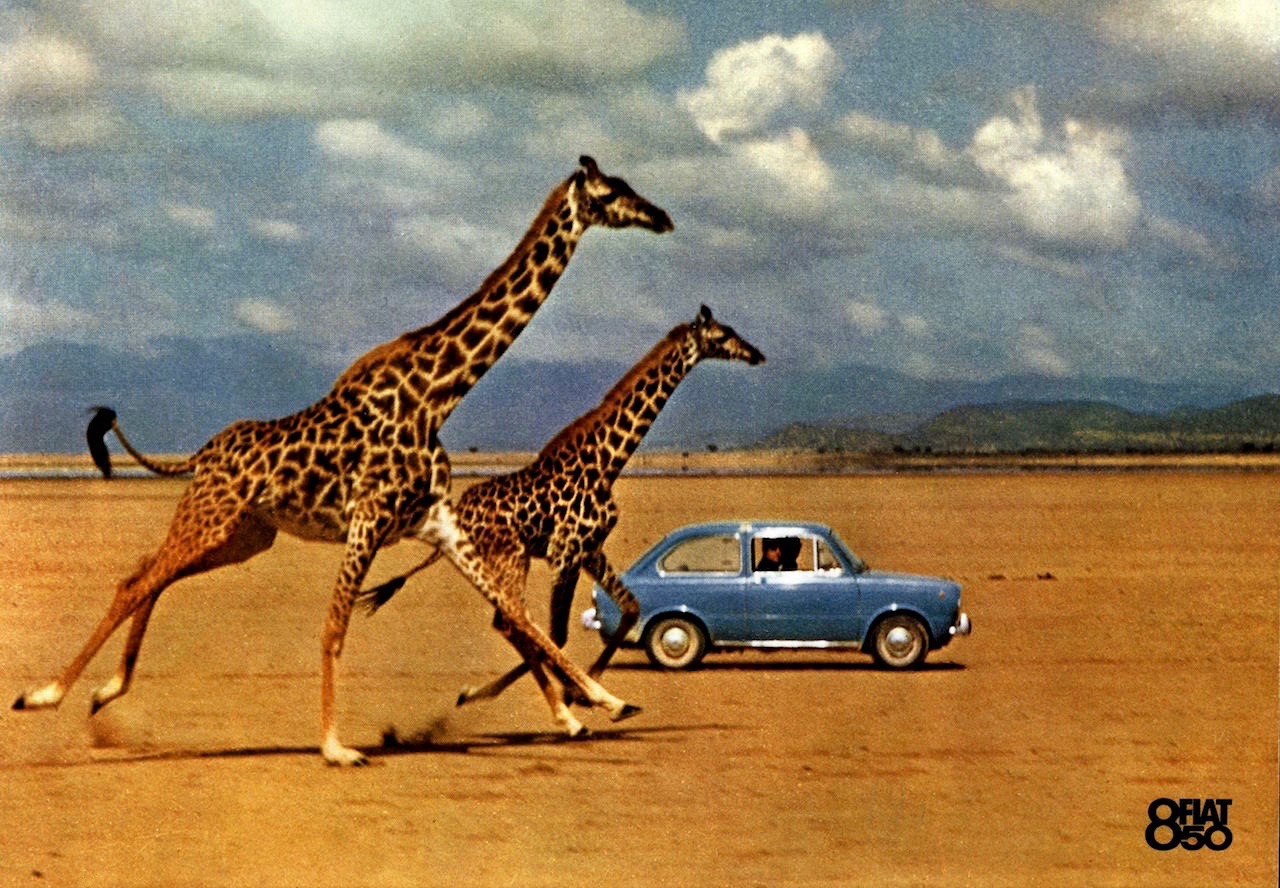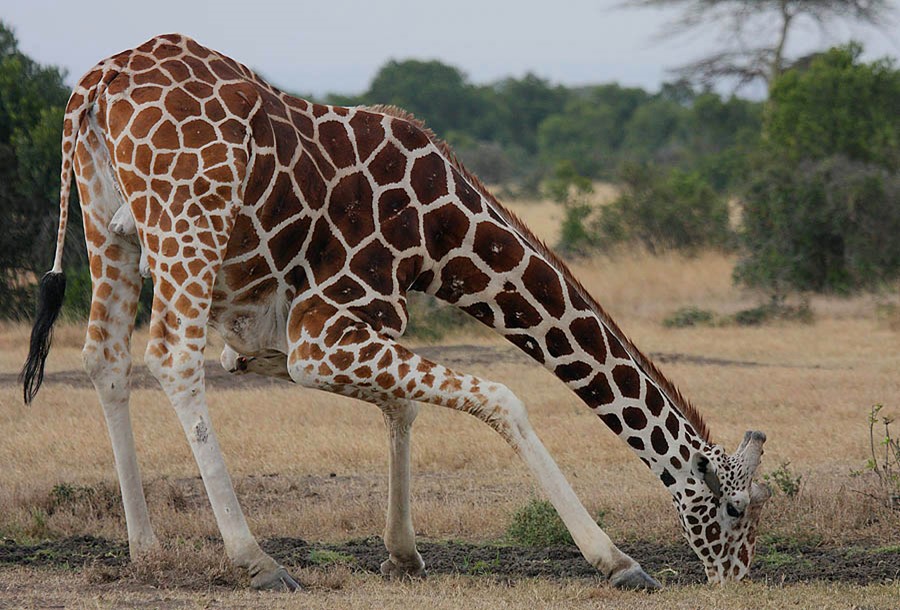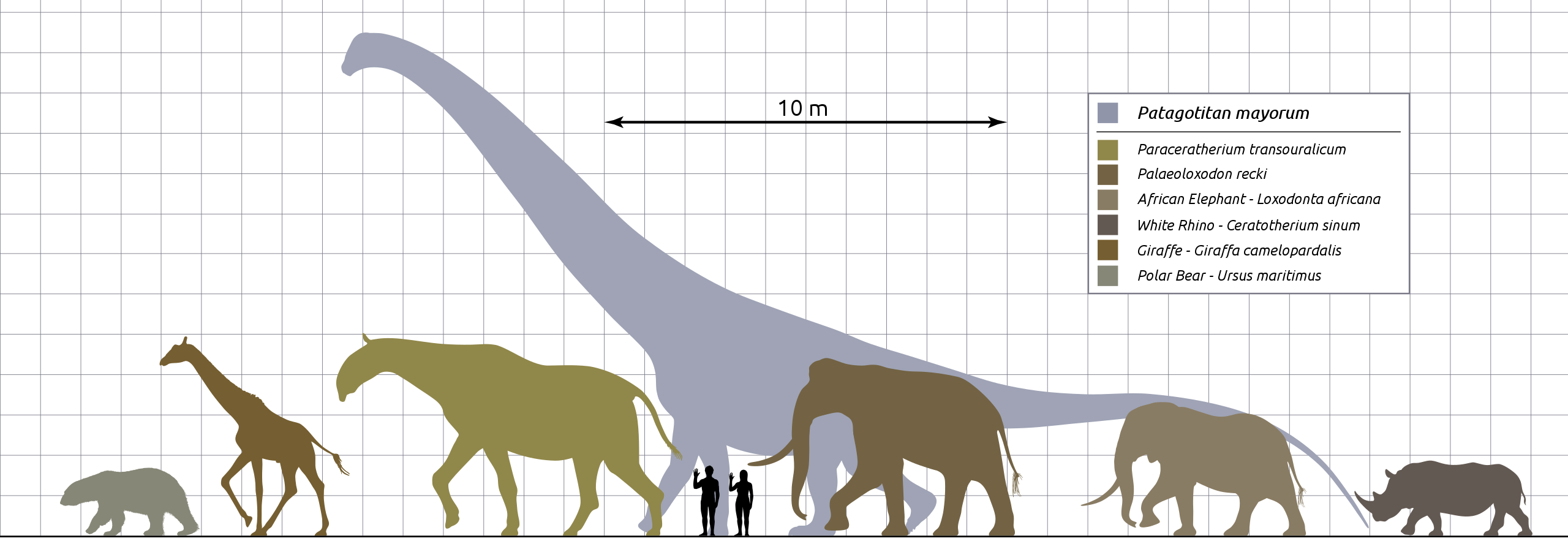
Credit: Roland H., via Wikimedia Commons
Giraffes are fascinating animals. They have the same number of vertebrae in their necks as humans do—seven—but each one is nearly a foot long.
They have long, purple tongues too—nearly two feet—that can grasp things as easily as a monkey’s tail can, which they use to pull leaves and fruits from high branches.
All four giraffe species are covered in spots. And each individual’s spots are as unique as a fingerprint.
But the most fascinating thing about giraffes...is their cardiovascular system.
Their head is so high up that to deliver normal blood pressure to their brain they must generate twice normal pressure at their heart. Enough blood pressure to kill a person.
They do that with a heart that’s two feet long and weighs up to 25 pounds.
They also have specialized one-way arteries. When a giraffe tilts its neck down, valves in its jugular close, storing up to a liter of blood, to keep it from flooding the brain.
When the giraffe lifts it head back up, the blood rushes out of the jugular back to the heart, pressurizing it so it can pump blood all the way back up the neck to the brain.
Arteries in the legs constrict to stop blood from pooling in the feet, and special connective tissue acts as natural compression socks.
The giraffe’s miraculous blood pressure control system is still not well understood by scientists. But they’re studying it to see if it might one day help humans manage our own high blood pressure.
Background
Synopsis: World Giraffe Day celebrates the land creature with the world’s longest neck on Earth’s longest day, the Summer Solstice. Statuesque giraffes are one of the most distinctive animals on Earth with their unique spots and elongated necks. Their cardiovascular system has evolved to manage the incredible blood pressures required to pump blood up to their brains. Sauropods had even longer necks.
- Ancient Greeks called them Giraffa camelopardalis because they thought they looked like a camel covered in a leopard’s coat.
- They live in the African savanna in small groups of about 6 to 20, known as herds or towers, and use their height to watch for predators and reach leaves on high tree limbs.

Distribution of giraffes in 2018.
Credit: BhagyaMani, via Wikimedia Commons - They can live up to 25 years.
- Populations have grown by 20% since 2015 to 117,000, although better surveying procedures may account for part of the increase.
- Four distinct species (southern, northern, Masai, reticulated) discerned in 2016 can be recognized by the characteristics of their spots.
- They live in the African savanna in small groups of about 6 to 20, known as herds or towers, and use their height to watch for predators and reach leaves on high tree limbs.
- Giraffes are Earth’s tallest land mammal, growing to 14 to 19 ft (4.2–5.8 m) in height.
- Their legs can be as long as 6 ft (1.8 m) enabling them to sprint at 35 mph (56 km/h) or cruise along at 10 mph (16 km/h).

Fiat 850 racing two giraffes from a May 1964 magazine ad when this car was introduced.
Credit: Unknown photographer, public domain, via Wikimedia Commons - They also use their legs for protection—a sharp kick can kill a lion.
- Their long necks are twice the length of any other land animal, reaching up to 8 ft (2.4 m) long.
- They have just seven vertebrae, the same number as humans, but each of the bones is around 10 in (25 cm). All mammals have seven vertebrae in their necks except sloths (5–7) and manatees (8–9).
- Giraffes probably evolved longer necks for grazing as well as for mating battles.
- Their legs can be as long as 6 ft (1.8 m) enabling them to sprint at 35 mph (56 km/h) or cruise along at 10 mph (16 km/h).
- During mating, bulls may butt each other’s necks, but the battles end with one bull walking away and injuries are minimal.
- Giraffes have hair-covered bony horns called ossicones that are only used by males during mating displays.
- Adult giraffes spend about 75% of their waking time consuming more than 143 lb (65 kg) of leaves per week, regurgitating it to chew as cud similar to cows.
- They must travel constantly to find enough food.
- They prefer flowers and fruit but use their height to graze on leaves and buds high up in their favorite acacia treetops that other animals can’t reach.
- Their tongues are protected from sunburn by their deep purple color and may be 20 in (51 cm) long to wrap around and grab tasty morsels.
- Giraffes get most of their water from the leaves they consume.
- They only drink from ponds or streams once every few days because spreading their legs and bending down is awkward, making them vulnerable to predators.

An adult male reticulated giraffe is vulnerable when it bows down to drink at Ol Pejeta Ranch, Kenya.
Credit: Steve Garvie from Dunfermline, Fife, Scotland, via Wikimedia Commons - For the same reason, they usually sleep upright, or, if settling on the ground, they take a nap of just 5 to 6 minutes.
- They only drink from ponds or streams once every few days because spreading their legs and bending down is awkward, making them vulnerable to predators.
- Female giraffes often return to their birthplace and give birth standing up.
- Their infants fall 5 ft to the ground at birth, but the calves can stand in about 30 minutes and are able to run along with their mothers within 10 hours.

One-day-old baby giraffe (Giraffa camelopardalis), Willow, stands by her mother.
Credit: Ralph Daily, via Wikimedia Commons
- Their infants fall 5 ft to the ground at birth, but the calves can stand in about 30 minutes and are able to run along with their mothers within 10 hours.
- Giraffe spots are like fingerprints, no two individuals have the same patterns, but spot patterns have been shown to be passed down to offspring from mothers.

A giraffe mother and calf in Masai Mara National Reserve, Kenya.
Credit: Lisa H lh_photography, public domain, via Wikimedia Commons- Spots help to regulate body temperature, to camouflage, and to aid in species recognition.
- Larger and more irregularly shaped spots appear to improve a calf’s chance of survival in their first year of life, possibly by making them more obvious to their herd.
- High blood pressure is essential to giraffes—their hearts have to overcome gravity to pump blood up their necks to their heads and compensate when blood rushes toward their heads as they bend down to drink.
- Normal human blood pressure is 120/80 or below.
- In order to maintain 110/70 at the brain, the giraffe heart must maintain 220/180.
- When they lower their heads to drink, blood pressure in the head should increase to around 300/200.
- When they lift their heads again, blood pressure drops back to 100/70.

Group of reticulated giraffes drinking around sunset at Okaukuejo Waterhole in Etosha National Park in Namibia. Giraffes must spread their forelegs and bow down to get their heads to water on the ground.
Credit: "Axel Tschentscher", via Wikimedia Commons
- While these dramatic blood pressure shifts would cause humans to faint, giraffes have evolved cardiovascular mitigation strategies that buffer these extreme blood pressure variations.
- Their heart is 2 ft (60 cm) long and weighs up to 25 lbs (11.3 kg).
- While high blood pressure causes fibrosis in human ventricles that can be fatal, giraffes have genes that prevent the stiffening of thicker heart muscles.
- Their heart rhythm has an extended stroke as the left ventricle fills to allow the heart to pump more blood with each stroke.
- When they bend over, they have one-way valves in their veins that make it possible to store up to a quart (1 l) of blood in their jugular veins so there is less blood at the heart, decreasing the pressure of each heartbeat.
- When their head swings upward, blood rushes from the jugular veins to the heart enabling it to pump a high-pressure stroke to get blood up to the elevated brain.
- Giraffes have built in support socks made of dense connective tissue in their legs and arteries with one-way flow restrictors in their legs.
- Paleontologists that study long-necked sauropods with necks up to 30 ft (8 m) long hypothesize that these Mesozoic creatures required twice the blood pressure of giraffes (four times that of humans) to get blood to their brains.

A size comparison between the one of the largest sauropod dinosaurs and various large land mammals. How did sauropods pump blood to their brains? Lacking evidence from soft parts, scientists can only speculate.
Credit: Steveoc 86, via Wikimedia Commons- It is thought these dinosaurs had some cardiovascular characteristics similar to giraffes but also evolved special elongated ribs in their necks that helped to both pump blood to their brains and to stabilize the motion of their necks as they walked.

